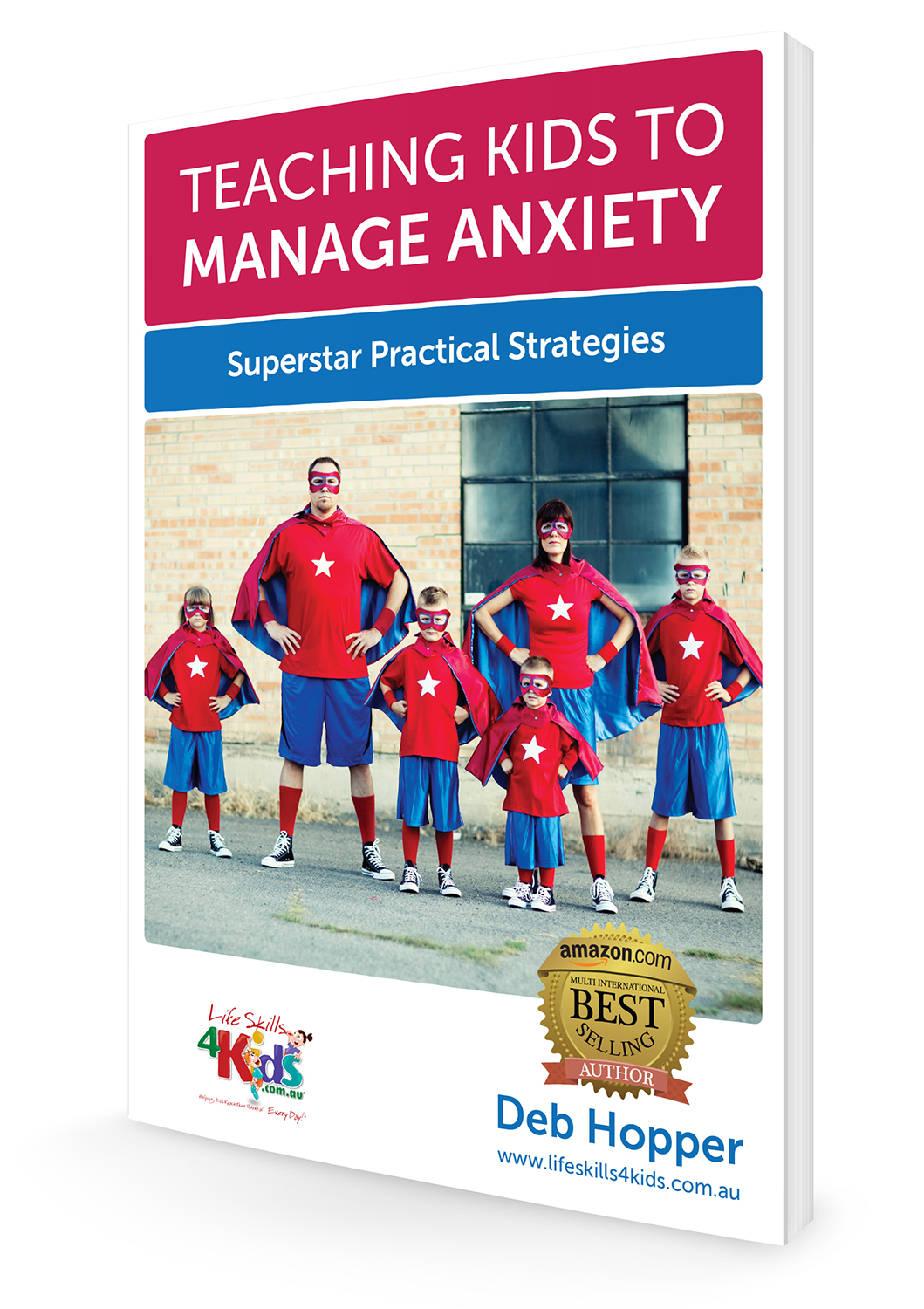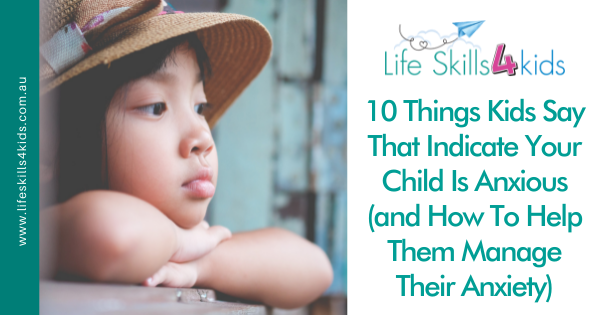Anxiety can show up in a myriad of ways and many children slip under the radar, go untreated, and are often misunderstood by their parents, teachers and peers.
Often children’s anxiety symptoms are misunderstood as “behavioural” issues. Being clingy, complaining, vigilant, or reacting or hitting peers on the playground can be labelled as purely behaviour related, when it can actually be driven by underlying anxiety.
It’s like the iceberg analogy where “behavioural” symptoms and associated commentary are what’s visible (the tip showing) and the anxiety is what’s hidden underneath the surface.
I work with children who are anxious for so many reasons:
- Anxious because of learning difficulties.
- Anxious because of physical awkwardness, clumsiness or disability.
- Anxious because of social anxiety.
- Anxious because of being unsure of transition anxiety in moving between home and school or class to class.
- Anxious because they need to be in control of their environment, but they can’t be… because we can’t control everything in life.
In many ways, anxiety has similar effects in adults and children alike but there are a few tell-tale phrases that can indicate your child is anxious.
1. “What’s wrong with me?”
Self-doubt and insecurity is OK in small amounts, but if it becomes habitual, small worries can grow into big ones. Yes, children need to be resilient and need regular, small challenges to continue to develop resilience, but keep watch for growing signs of other anxiety triggers that might make for more pronounced and longer term worries.
Encourage your child to believe in themselves, to celebrate their differences and love who they are. We are all different, we all have strengths and growth areas. Celebrate differences. As one of my therapy mum’s says, (and has tattooed on her arm) “Different, not less”.
2. “Please don’t make me” or “I don’t want to go to school”
Refusal to go to school can come from many reasons including difficulty with learning, difficulty with concentrating, difficulty with making friends, bullying, not knowing how to play, not knowing how to go up and say hi to a friend, or how to make new friends. Often by unpacking the reason why they don’t want to do something can give us clues about the strategy for what to do to help.
A whole team approach between parents, the school team and professionals involved can give the best outcome for a child who doesn’t want to go to school.
3. “I want to stay home” or “I don’t want to go”
Some children are extremely over whelmed with the sensory environment outside of home.
The noise, smells, tactile feel of seats or the touch demands of being at preschool can invoke severe anxiety in some children. Some children prefer to stay in quiet, familiar environments because it is much safer for their sensory and nervous systems.
When some children are placed in an overwhelming environment they can develop negative sensory memories which are triggered by the thought of being there, or the recollection of being in that situation when they become close to the place.
For example, a child might become anxious and react negatively to a sensory memory when mum mentions that she needs to go to the shops, or when they are driving towards the shops. The sensory memory is the trigger for the environment.
4. “I don’t want to….. I’m tired”
Can you recall being so nervous or anxious before a talk, an exam or a job interview? Do you recall coming home absolutely exhausted that afternoon?
For your child at preschool or school, who has to deal with changes in routines, changes in teachers, noise, lots of people or other day to day yet stressful events, your child can become worn out because of anxiety.
Anxious thoughts can wear them down and also bring on sleep disturbance which in turn results in increased tiredness. Children often find it hard to get to sleep because they are thinking about the day, thinking what went wrong, thinking about how to solve what didn’t go well and worrying how they will tackle the day tomorrow.
Many children (and adults) become so fatigued that when they do have down time and the opportunity to be alone, they may revert to sleep to physically recover from the emotional fatigue that has been building up.
5. “You do it”, “I can’t” or “I don’t want to!”
A child who constantly has a low self-esteem, thinks he can’t do it, refuses to participate, withdraws from activities, and attempts to get others to act on their behalf, has many key signs of an anxious child.
We need to step back, be the detective, and look for clues for WHY your child feels they don’t want to give things a go. WHY are they withdrawing? WHY don’t they want to?
- Are they being bullied?
- Do they have low muscle tone that makes it hard for them to move?
- Do they feel uncoordinated compared to their peers?
- Do they not have the muscle strength to pull themselves up onto climbing equipment?
- Do they want to play and participate but they can’t?
Thinking outside the box is our job as parents and professionals. Don’t just assume that your child is lazy because they don’t want to participate. Be detectives with them. Ask about their day! Find out clues as to why they are worried. Once you have some clues, you can help to get an action plan together.
6. “I’m sorry”, “I’m sorry”, “I’m sorry”.
Anxious children (and adults) often apologise for things that aren’t real issues, and then they withdraw. It’s kind of a sign of a plea for help, a way to get attention for a short period. It can also be a sign that they aren’t confident and have low self image or low self esteem.
Encouraging children to be confident in their opinion, even in the small things is so important. I worked with a tween once who had such a low self image and anxiety that she couldn’t even say how she liked her eggs cooked.
Start with encouraging a child’s point of view in small things from day to day and confidence will grow in small but important steps.
7. “When are we going?”, “I want to go home”, or “I’ve got to get out of here”
Being out of your house which is your cocoon, your comfort zone, your safe place is not the first choice for fun when you are anxious.
For anxious kids, they might really want to go to that birthday party, play date or school dance. However, instead of enjoying their time, or finding something to do, they will often cling to parents or display negative behaviour or negative interactions with friends in order to get an adult’s attention and either get in trouble or make the experience so uncomfortable that they are asked to leave or want to leave.
Again the reasons for this might be social anxiety, too much noise or too many people and they are overwhelmed from a sensory perspective or just not having the social skills or co-ordination to know how to play without breaking up the game.
8. “Don’t leave”
Many children don’t feel comfortable with being left at a different place and prefer to be near a safe and trusted person. This is normal for younger children, but when a middle primary school child or teen doesn’t want to be dropped off at school or at a trusted friend’s house, warning bells might sound.
9. “Can you leave the light on for me at night?”
Many children prefer to have a night light on over night. However, if a child is finding it hard to get to sleep, or waking up terrified, needing to check door locks, or being terrified in their bed for hours, then perhaps they could use some support in dealing with their anxious and negative thoughts.
Movies, stories and conversations with peers can trigger this thinking, but it can stem from many other things throughout childhood.
10. “I feel sick” or hair pulling.
When anxiety strikes, it shows up in many different ways. Some are physically obvious, others are not.
Children struggling with anxiety may often complain of a sore tummy or feeling sick in the stomach. Some children will also fake sickness and do anything possible to prove to parents that they are truly sick and can’t go to school or can’t do something. I worked with one child who used to fake a temperature. They asked for a hot water bottle and then put the thermometer on the hot water bottle to prove they were too sick to go to school.
The gut is strongly connected to feelings and well-being, even as an adult, so a constant complaint of a “sore tummy” can be a sign of anxiety in your child.
Hair pulling or trichotillomania can affect some children so much that they create a bald spot on the crown of their head. Another child I worked with was so nervous and anxious that he pulled his hair to self calm and after a few months did have a bald spot on the crown of his head, a direct result of anxiety about school.
Signs of Anxiety in Children
For both adults and children, symptoms of anxiety can include:
- Avoiding new things
- Distressed by normal changes, breaks from routine, or taking risks
- Tendency to highlight the negative
- May ask many unnecessary questions
- Physical complaints – Feeling nauseous, panicked, or sick
- Perfectionist
- Difficulty sleeping
- Argumentative (but rarely aggressive)
- Very clingy outside of home or asking for reassurance
- Avoiding unfamiliar situations
- Fatigue
- Difficulty concentrating
- Poor memory
- Irritability
- Muscle tension
- Difficulty controlling the worry
Many children have anxiety that comes and goes, dependent on tests, social difficulties, friends moving away, joining a new school or other life events.
“However, when anxiety is constantly present and appears to be an irrational fear of familiar activities or situations, then it is no longer a coping mechanism but rather a disabling condition (National Institute of Mental Health (NIMH, n.d.).”
10 Ways To Help Your Child Manage Their Anxiety
- Regular physical exercise. Movement feeds your limbic system and your kinesthesia receptors and releases happy hormones.
- Encourage healthy eating – sugar or white foods can impact on moods immediately and for the following hours and days.
- Communicate effectively with your child
- Be aware of and remove or modify the sensory environment or sensory overload if needed
- Minimise technology. Screen time is very stimulating and can impact on anxiety
- Meditation, prayer, stretching or kids yoga help to slow down running minds
- Prepare your child for events or actions known to trigger their anxiety
- Establish routines. A safe routine and knowing what is coming up feels safer to children
- Learn stress-management techniques eg breathing, stretching, kids yoga
- Seek support. Ask you health care nurse, general practitioner, therapist or teacher.
For more tools and techniques that parents, teachers and therapists can use to help children with anxiety, check out my Parent Toolbox – A 4 part video series on how to help children manage and overcome their anxiety for a calmer and more confident life.
Teaching Kids to Manage Anxiety: Superstar Practical Strategies (eBook)
Kids today are growing up in a fast-paced world where information and opportunity overload can be overwhelming.
Based on many years of clinical experience as an Occupational Therapist, Deb Hopper has been using her Just Right Kids® Model to teach children to communicate and manage their stress and anxiety by:
– Identifying their “body speed”,
– Understanding their stress triggers, and
– Implementing simple strategies to reduce anxiety and stress.


